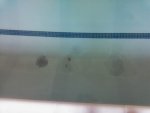Have a pool thatis six years old now and i have been managing it for 5 now. The first year of its life it was a traditional chlorine pool and im not sure about its first years chemical balance history. When i took over the retirement community that its in decided to go to a saltwater pool and my chemicals have been within acceptable limits for 5 years now with the exception of a power loss, cleaning or drain and fill. About two years ago the plaster started chipping up in the pool and the pieces that are chipping up are coming directly off of concrete below but the pieces are hardly a quarter inch in thickness. I know there is a certain timeline for a new pool that everything has to be done right ex. filling, brushing, sequestrate etc., just wondering if there could have been an incorrect installation. As i stated my chemicals have been correct for years and just wondering if anyone has any insight that could help me withthis contractor. 


